Bingxi Liu
TrackingMiM: Efficient Mamba-in-Mamba Serialization for Real-time UAV Object Tracking
Jul 02, 2025Abstract:The Vision Transformer (ViT) model has long struggled with the challenge of quadratic complexity, a limitation that becomes especially critical in unmanned aerial vehicle (UAV) tracking systems, where data must be processed in real time. In this study, we explore the recently proposed State-Space Model, Mamba, leveraging its computational efficiency and capability for long-sequence modeling to effectively process dense image sequences in tracking tasks. First, we highlight the issue of temporal inconsistency in existing Mamba-based methods, specifically the failure to account for temporal continuity in the Mamba scanning mechanism. Secondly, building upon this insight,we propose TrackingMiM, a Mamba-in-Mamba architecture, a minimal-computation burden model for handling image sequence of tracking problem. In our framework, the mamba scan is performed in a nested way while independently process temporal and spatial coherent patch tokens. While the template frame is encoded as query token and utilized for tracking in every scan. Extensive experiments conducted on five UAV tracking benchmarks confirm that the proposed TrackingMiM achieves state-of-the-art precision while offering noticeable higher speed in UAV tracking.
EmbodiedPlace: Learning Mixture-of-Features with Embodied Constraints for Visual Place Recognition
Jun 16, 2025Abstract:Visual Place Recognition (VPR) is a scene-oriented image retrieval problem in computer vision in which re-ranking based on local features is commonly employed to improve performance. In robotics, VPR is also referred to as Loop Closure Detection, which emphasizes spatial-temporal verification within a sequence. However, designing local features specifically for VPR is impractical, and relying on motion sequences imposes limitations. Inspired by these observations, we propose a novel, simple re-ranking method that refines global features through a Mixture-of-Features (MoF) approach under embodied constraints. First, we analyze the practical feasibility of embodied constraints in VPR and categorize them according to existing datasets, which include GPS tags, sequential timestamps, local feature matching, and self-similarity matrices. We then propose a learning-based MoF weight-computation approach, utilizing a multi-metric loss function. Experiments demonstrate that our method improves the state-of-the-art (SOTA) performance on public datasets with minimal additional computational overhead. For instance, with only 25 KB of additional parameters and a processing time of 10 microseconds per frame, our method achieves a 0.9\% improvement over a DINOv2-based baseline performance on the Pitts-30k test set.
SuperPlace: The Renaissance of Classical Feature Aggregation for Visual Place Recognition in the Era of Foundation Models
Jun 16, 2025Abstract:Recent visual place recognition (VPR) approaches have leveraged foundation models (FM) and introduced novel aggregation techniques. However, these methods have failed to fully exploit key concepts of FM, such as the effective utilization of extensive training sets, and they have overlooked the potential of classical aggregation methods, such as GeM and NetVLAD. Building on these insights, we revive classical feature aggregation methods and develop more fundamental VPR models, collectively termed SuperPlace. First, we introduce a supervised label alignment method that enables training across various VPR datasets within a unified framework. Second, we propose G$^2$M, a compact feature aggregation method utilizing two GeMs, where one GeM learns the principal components of feature maps along the channel dimension and calibrates the output of the other. Third, we propose the secondary fine-tuning (FT$^2$) strategy for NetVLAD-Linear (NVL). NetVLAD first learns feature vectors in a high-dimensional space and then compresses them into a lower-dimensional space via a single linear layer. Extensive experiments highlight our contributions and demonstrate the superiority of SuperPlace. Specifically, G$^2$M achieves promising results with only one-tenth of the feature dimensions compared to recent methods. Moreover, NVL-FT$^2$ ranks first on the MSLS leaderboard.
MT-PCR: A Hybrid Mamba-Transformer with Spatial Serialization for Hierarchical Point Cloud Registration
Jun 16, 2025Abstract:Point cloud registration (PCR) is a fundamental task in 3D computer vision and robotics. Most existing learning-based PCR methods rely on Transformers, which suffer from quadratic computational complexity. This limitation restricts the resolution of point clouds that can be processed, inevitably leading to information loss. In contrast, Mamba-a recently proposed model based on state space models (SSMs)-achieves linear computational complexity while maintaining strong long-range contextual modeling capabilities. However, directly applying Mamba to PCR tasks yields suboptimal performance due to the unordered and irregular nature of point cloud data. To address this challenge, we propose MT-PCR, the first point cloud registration framework that integrates both Mamba and Transformer modules. Specifically, we serialize point cloud features using Z-order space-filling curves to enforce spatial locality, enabling Mamba to better model the geometric structure of the input. Additionally, we remove the order indicator module commonly used in Mamba-based sequence modeling, leads to improved performance in our setting. The serialized features are then processed by an optimized Mamba encoder, followed by a Transformer refinement stage. Extensive experiments on multiple benchmarks demonstrate that MT-PCR outperforms Transformer-based and concurrent state-of-the-art methods in both accuracy and efficiency, significantly reducing while GPU memory usage and FLOPs.
TextInPlace: Indoor Visual Place Recognition in Repetitive Structures with Scene Text Spotting and Verification
Mar 09, 2025Abstract:Visual Place Recognition (VPR) is a crucial capability for long-term autonomous robots, enabling them to identify previously visited locations using visual information. However, existing methods remain limited in indoor settings due to the highly repetitive structures inherent in such environments. We observe that scene text typically appears in indoor spaces, serving to distinguish visually similar but different places. This inspires us to propose TextInPlace, a simple yet effective VPR framework that integrates Scene Text Spotting (STS) to mitigate visual perceptual ambiguity in repetitive indoor environments. Specifically, TextInPlace adopts a dual-branch architecture within a local parameter sharing network. The VPR branch employs attention-based aggregation to extract global descriptors for coarse-grained retrieval, while the STS branch utilizes a bridging text spotter to detect and recognize scene text. Finally, the discriminative text is filtered to compute text similarity and re-rank the top-K retrieved images. To bridge the gap between current text-based repetitive indoor scene datasets and the typical scenarios encountered in robot navigation, we establish an indoor VPR benchmark dataset, called Maze-with-Text. Extensive experiments on both custom and public datasets demonstrate that TextInPlace achieves superior performance over existing methods that rely solely on appearance information. The dataset, code, and trained models are publicly available at https://github.com/HqiTao/TextInPlace.
NocPlace: Nocturnal Visual Place Recognition Using Generative and Inherited Knowledge Transfer
Feb 27, 2024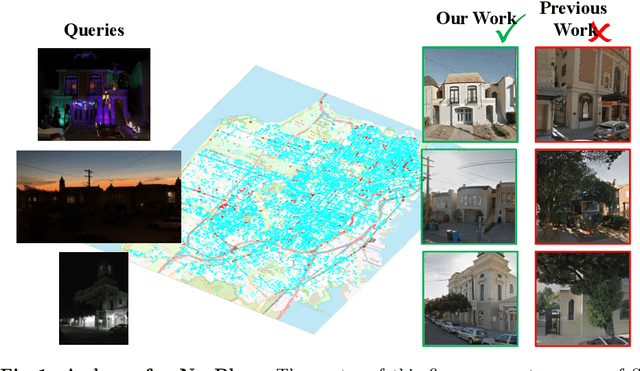

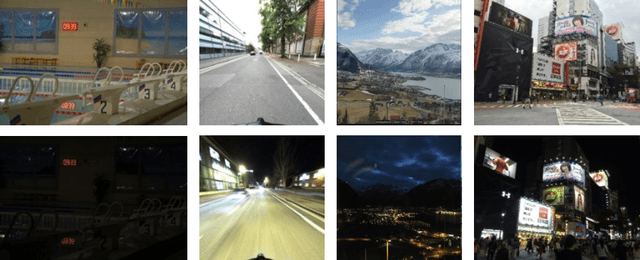
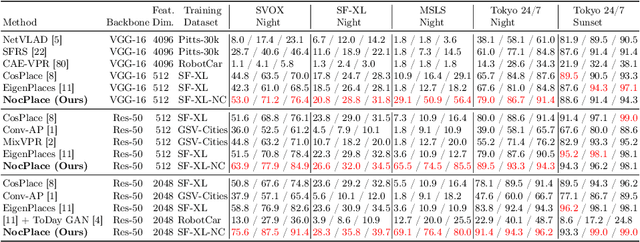
Abstract:Visual Place Recognition (VPR) is crucial in computer vision, aiming to retrieve database images similar to a query image from an extensive collection of known images. However, like many vision-related tasks, learning-based VPR often experiences a decline in performance during nighttime due to the scarcity of nighttime images. Specifically, VPR needs to address the cross-domain problem of night-to-day rather than just the issue of a single nighttime domain. In response to these issues, we present NocPlace, which leverages a generated large-scale, multi-view, nighttime VPR dataset to embed resilience against dazzling lights and extreme darkness in the learned global descriptor. Firstly, we establish a day-night urban scene dataset called NightCities, capturing diverse nighttime scenarios and lighting variations across 60 cities globally. Following this, an unpaired image-to-image translation network is trained on this dataset. Using this trained translation network, we process an existing VPR dataset, thereby obtaining its nighttime version. The NocPlace is then fine-tuned using night-style images, the original labels, and descriptors inherited from the Daytime VPR model. Comprehensive experiments on various nighttime VPR test sets reveal that NocPlace considerably surpasses previous state-of-the-art methods.
Deep Homography Estimation for Visual Place Recognition
Feb 25, 2024Abstract:Visual place recognition (VPR) is a fundamental task for many applications such as robot localization and augmented reality. Recently, the hierarchical VPR methods have received considerable attention due to the trade-off between accuracy and efficiency. They usually first use global features to retrieve the candidate images, then verify the spatial consistency of matched local features for re-ranking. However, the latter typically relies on the RANSAC algorithm for fitting homography, which is time-consuming and non-differentiable. This makes existing methods compromise to train the network only in global feature extraction. Here, we propose a transformer-based deep homography estimation (DHE) network that takes the dense feature map extracted by a backbone network as input and fits homography for fast and learnable geometric verification. Moreover, we design a re-projection error of inliers loss to train the DHE network without additional homography labels, which can also be jointly trained with the backbone network to help it extract the features that are more suitable for local matching. Extensive experiments on benchmark datasets show that our method can outperform several state-of-the-art methods. And it is more than one order of magnitude faster than the mainstream hierarchical VPR methods using RANSAC. The code is released at https://github.com/Lu-Feng/DHE-VPR.
NPR: Nocturnal Place Recognition in Streets
Apr 17, 2023



Abstract:Visual Place Recognition (VPR) is the task of retrieving database images similar to a query photo by comparing it to a large database of known images. In real-world applications, extreme illumination changes caused by query images taken at night pose a significant obstacle that VPR needs to overcome. However, a training set with day-night correspondence for city-scale, street-level VPR does not exist. To address this challenge, we propose a novel pipeline that divides VPR and conquers Nocturnal Place Recognition (NPR). Specifically, we first established a street-level day-night dataset, NightStreet, and used it to train an unpaired image-to-image translation model. Then we used this model to process existing large-scale VPR datasets to generate the VPR-Night datasets and demonstrated how to combine them with two popular VPR pipelines. Finally, we proposed a divide-and-conquer VPR framework and provided explanations at the theoretical, experimental, and application levels. Under our framework, previous methods can significantly improve performance on two public datasets, including the top-ranked method.
A Convolutional-Transformer Network for Crack Segmentation with Boundary Awareness
Feb 23, 2023Abstract:Cracks play a crucial role in assessing the safety and durability of manufactured buildings. However, the long and sharp topological features and complex background of cracks make the task of crack segmentation extremely challenging. In this paper, we propose a novel convolutional-transformer network based on encoder-decoder architecture to solve this challenge. Particularly, we designed a Dilated Residual Block (DRB) and a Boundary Awareness Module (BAM). The DRB pays attention to the local detail of cracks and adjusts the feature dimension for other blocks as needed. And the BAM learns the boundary features from the dilated crack label. Furthermore, the DRB is combined with a lightweight transformer that captures global information to serve as an effective encoder. Experimental results show that the proposed network performs better than state-of-the-art algorithms on two typical datasets. Datasets, code, and trained models are available for research at https://github.com/HqiTao/CT-crackseg.
Leveraging Local and Global Descriptors in Parallel to Search Correspondences for Visual Localization
Sep 23, 2020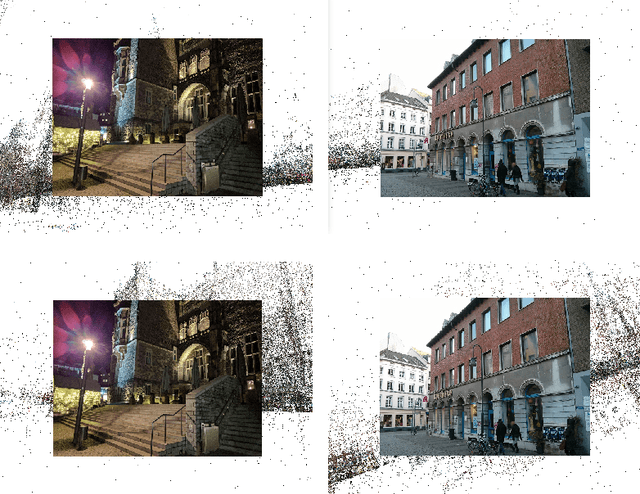
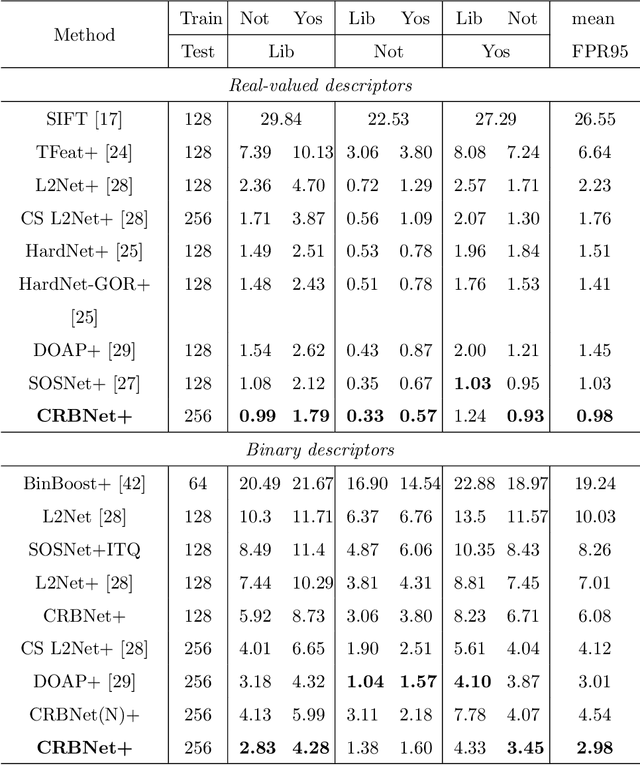
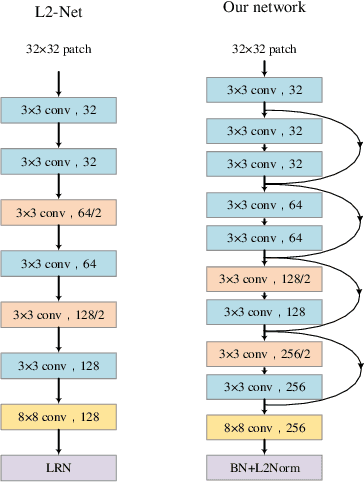

Abstract:Visual localization to compute 6DoF camera pose from a given image has wide applications such as in robotics, virtual reality, augmented reality, etc. Two kinds of descriptors are important for the visual localization. One is global descriptors that extract the whole feature from each image. The other is local descriptors that extract the local feature from each image patch usually enclosing a key point. More and more methods of the visual localization have two stages: at first to perform image retrieval by global descriptors and then from the retrieval feedback to make 2D-3D point correspondences by local descriptors. The two stages are in serial for most of the methods. This simple combination has not achieved superiority of fusing local and global descriptors. The 3D points obtained from the retrieval feedback are as the nearest neighbor candidates of the 2D image points only by global descriptors. Each of the 2D image points is also called a query local feature when performing the 2D-3D point correspondences. In this paper, we propose a novel parallel search framework, which leverages advantages of both local and global descriptors to get nearest neighbor candidates of a query local feature. Specifically, besides using deep learning based global descriptors, we also utilize local descriptors to construct random tree structures for obtaining nearest neighbor candidates of the query local feature. We propose a new probabilistic model and a new deep learning based local descriptor when constructing the random trees. A weighted Hamming regularization term to keep discriminativeness after binarization is given in the loss function for the proposed local descriptor. The loss function co-trains both real and binary descriptors of which the results are integrated into the random trees.
 Add to Chrome
Add to Chrome Add to Firefox
Add to Firefox Add to Edge
Add to Edge